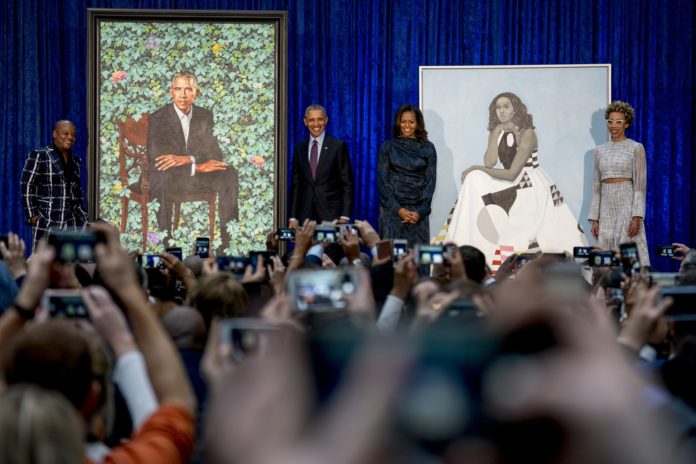
By Vivian Kwok | Reporter
The portrait of President Barack Obama by Kehinde Wiley and the portrat of Michelle Obama by Amy Sherald unveiled on Feb. 12 accumulated controversy, critiques and comparisons alike.
However, according to artnet news, the “National Portrait Gallery saw a 311 percent increase in visitors year over year for President’s Day Weekend. Compared to 16,041 visitors over the same three days in 2017, the holiday weekend saw 50,024 guests cross the threshold this year.”
No matter the degree of controversy, the significant increase in viewership of the portraits speaks into the message they convey –– the stories surrounding both the pieces and the artists provide insight about the significance of the paintings within the context of today’s contemporary art world.
Associate professor of art history Dr. Nathan Elkins said part of the controversy over these portraits is because they are so avante-garde.
“There’s this idea that you should have this universal, standard portrait,” Elkins said.
Assistant professor of art Michael Darough said the controversy derives from the artists’ choice to break the molds of using typical color pallets, poses and dimensions.
“If you look at these portraits in comparison to other presidential portraits, they’re very much so contemporary,” Darough said. “It’s still in the same vain as a presidential portrait, but the approach to it is speaking to this time period, and the artists that they chose I think reflect the current direction of contemporary painting.”
Another popular talking point is that the chosen artists are the first African Americans to create presidential portraits. Elkins said he thinks someone like Wiley is appropriate for making the portrait of the first African American president in history.
“[Wiley’s] been playing with this idea of our expectations when we look at historical artworks and inserting the African American into the history of art where he was never represented,” Elkins said.
Darough said the background of Wiley’s portrait even provides symbolic insight to President Obama’s heritage.
“When you look at it, it’s lush and green,” Daroguh said. “It’s got all these different flowers, but those flowers represent different points in Obama’s life. He has a flower from Hawaii where he grew up. He has a flower from Chicago where he lived. He’s also got a flower from Kenya. All those little-bity facets contribute to the person, even though it just seems like a blank back drop.”
Neither Darough nor Elkins personally knew much about Sherald. However, Rockwall senior Katie Stewart said Sherald is newer in the art world but still has a fascinating story.
“She’s just trying to sell her paintings, pay off her student loans and get enough money where she can afford to pay for her medication,” Stewart said.
Stewart said she read that Sherald’s father wanted her to pursue dentistry, but art was her true passion. Stewart also said she read that Sherald lost her father to Parkinson’s disease and her brother to lung cancer, and Sherald has her own health burdens.
“She’s a human. It’s very humanizing to know the artist behind the work,” Stewart said.
Sherald has received some criticism about her style, especially regarding the way she portrayed Michelle Obama. In contrast, Stewart said she sees life within the portrait.
“We’re so used to seeing something so hyper realistic that when it’s not hyper realistic, it’s almost dissatisfying. But it’s still beautiful,” Stewart said. “I kind of feel like she could get up and walk away. You see the movement of her dress. She’s still there.”
Another critique is that Sherald’s painting of Michelle Obama contrasts from Wiley’s portrait of former president Obama even though they are both contemporary artists. However, Stewart and Darough both appreciate their differences.
“Michelle Obama is just painted in a different way. It’s not necessarily one is better than the other,” Stewart said. “They’re different, but they’re complimentary just like [the Obamas] are.”
Darough said the portrait of Michelle Obama draws viewers’s eyes in different directions, and that he likes both portraits for several reasons.
“I think having the differences showcases the different personalities in terms of the artists, but it also showcases the different personalities in terms of the individuals they’re painting,” Darough said.
Though controversy and criticism batter the presidential portraits, many viewers, including the Obamas and the National Portrait Gallery, approve of them.
“I love the uniqueness of their portraits. It’s a testament to the time. It’s a testament to the artwork that’s being created today as opposed to sticking to the standard mold,” Darough said.
The portraits have garnered record attention at the National Portrait Gallery, “where thousands of visitors lined up for hours to see the works and snap selfies in front of them;” given the stories behind the paintings, it’s no wonder they have sparked such a reaction.





